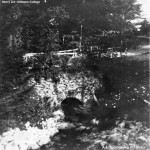Gordon Smith
Natural History of the Berkshires
12/05/09
Field Blog #9: Past and Present
Today, when I visited my site, the area looked drastically different from the way it looked on September 13th when I conducted my first visit to the Mission Park grove. It was 3:30, cloudy and chilly, but not cold, with a cool breeze blowing through.
While the temperature and overcast sky may have had an influence on how I perceived the site, it definitely felt, looked, and even smelled dormant. The vibrant summer energy of the area is absent, replaced by the sleepiness of winter. Simply looking at the site tells the same story: where in September the entire surrounding area exploded in every hue of bright green, brown now dominates the site. Brown crusty leaves cover large percentages of the site, which gives the appearance that the ground has completely left its productive period. While it may seem as if under the leaves would be some greenery, this is not the case. Two plants represent the green that is left on the ground: the tall grass in the sunny areas of the site and wild garlic mustard. The grass, while it still seems well enough alive, is growing increasingly thin, low, and pale, with some of it having already turned brown. Garlic mustard also still has all of its color and is the only ground plant that remains dark green.
The other ground plants that had inhabited the site have long since gone into their dormant stages. The flowering plants were the first to go, though their parents in some cases remained for a time hiding among the other ground cover. The sensitive fern was gone after the very first frost on October 18th, and the bracken fern lasted two weeks longer. About the same time, the large amount of Virginia creeper sprouts on the ground also disappeared, as did the white wood aster. While goutweed has the ability to survive the winter and live perennially, it also, seemingly, has the unfortunate disadvantage of being tasty to deer. Today’s inspection saw the last significant patch of the before very populous plant completely grazed. Interestingly, thick carpets of garlic mustard, which remained completely untouched, surrounded this grazed patch almost completely. It seems that though the exotic was imported for its culinary properties, it is not much appreciated by the local fauna.
The deciduous trees have all been completely devoid of leaves for some time now, though the evergreens still appear as they did when I first saw them. Unfortunately, their foliage does not compensate for the deciduous leaves, whose absence makes the site feel open, and almost empty. As a side note, the conifers that I believed to be all one species when I first gave them a cursory glance in fact include the species white pine, eastern hemlock, white spruce, and northern white cedar, in addition to a small Japanese umbrella tree.
The brown patches where at the beginning of the semester I was able to see some dirt used to be confined underneath the branches of the biggest white pines, but are now spread throughout much of the interior of the site. While pine cones and needles still litter the area, they do not blanket it as they did even last week, allowing dirt to be seen easily in reasonably sized expanses.
Today, the fauna was also different from what I had become used to seeing during my visits to the site. Not at any point in the 45 minutes that I spent on the site did I see or hear any of the now very obese gray squirrels or chipmunks that had been out in force even last week. Of course, this is reasonable, as cooler temperatures that have slowly been coming in may have triggered the squirrels’ hibernation behavior, though some of the days (like today) remain comparatively warm. It is also possible that the gray squirrel’s hibernation behavior is based on day length (photoperiod) rather than temperature, and that even on a hot but short day, they will not be active.  Furthermore, I heard no birdcalls other than crows.
To mention my site’s future, it is likely to remain the same. As a historical park, groundskeepers have been maintaining the site in its current (or very close to its current) set up for years, and will likely continue to do so for

